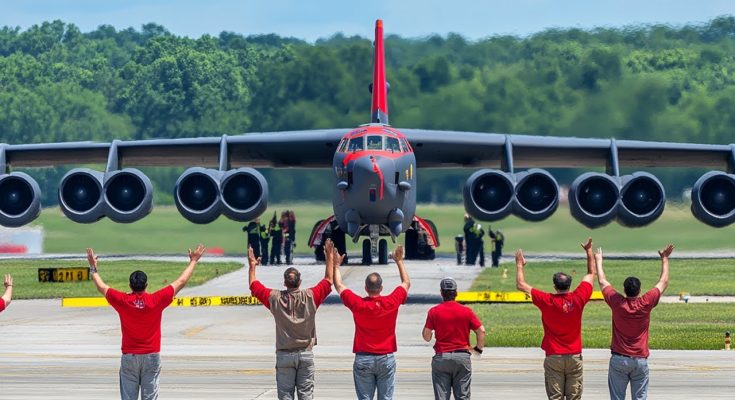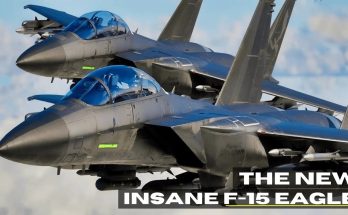The B-52 Stratofortress, one of the most iconic and enduring aircraft in the U.S. Air Force’s fleet, is known for its sheer power and versatility, especially when it comes to bombing and long-range operations. However, its ability to perform emergency takeoffs at full speed is a testament to its impressive engineering and the highly trained crews that operate it. Here’s a closer look at how the B-52’s powerful design and capabilities enable such feats and why it’s considered a “monster bomber.”
1. Engine Power and Performance
The B-52 is powered by eight turbofan engines, each capable of producing over 17,000 pounds of thrust. This gives the aircraft an exceptional power-to-weight ratio, allowing it to take off at full speed even in emergency scenarios. These engines are renowned for their reliability, which is critical when performing high-stress maneuvers such as emergency takeoffs.
In an emergency situation, the crew can push the B-52 to its maximum takeoff speed, which is typically around 150–160 knots (about 170–185 mph). The engines’ raw power allows the B-52 to achieve lift quickly, even when heavily loaded with bombs or other payloads.
2. Full-Speed Emergency Takeoff
An emergency takeoff at full speed is a rare but potentially life-saving maneuver that involves accelerating the aircraft to its maximum takeoff speed as quickly as possible. In normal circumstances, a bomber like the B-52 gradually increases speed during takeoff, but in an emergency situation—such as avoiding an incoming threat or rapidly escaping a compromised airfield—the crew may need to accelerate as quickly as possible.
To achieve a full-speed emergency takeoff:
-
The crew would typically use the full throttle to maximize engine power.
-
The aircraft’s landing gear must be reinforced and robust enough to handle the rapid acceleration and the weight of the B-52, especially during a loaded takeoff.
-
The runway length and conditions would need to support such a maneuver. The B-52 requires a longer runway than many other aircraft due to its size and weight, but the ability to achieve takeoff speed quickly still remains possible in the right conditions.
3. Strategic Importance of the B-52
The B-52 has been a cornerstone of the U.S. Air Force’s strategic deterrence capability for more than six decades, serving as a long-range, nuclear-capable bomber. Its role in carrying nuclear payloads ensures that it can be a deterrent force even in the most extreme and hostile environments.
The B-52 is capable of carrying a wide variety of ordnance, from nuclear bombs to precision-guided munitions (PGMs). Its payload capacity is massive, allowing it to carry up to 70,000 pounds of munitions, including bombs, missiles, and guided weapons, depending on mission requirements.
This strategic capability means that the B-52 often needs to operate in hostile environments where emergency takeoffs may be required to avoid threats such as incoming missiles, anti-aircraft fire, or other aerial dangers.
4. Emergency Takeoff Scenarios
While the B-52 is generally used for strategic bombing missions, there are scenarios in which an emergency takeoff might be necessary. Some of these situations could include:
-
Threat detection: If the B-52 is on a bombing run and encounters a surface-to-air missile (SAM) or hostile aircraft, an emergency takeoff might be needed to evade the threat.
-
Combat zones: In areas with high threats, such as near enemy territory or a compromised airfield, the ability to take off at full speed could ensure the bomber escapes rapidly without falling victim to ground-based threats.
-
Malfunction recovery: If a malfunction occurs during takeoff, the crew may need to perform emergency procedures to get the aircraft airborne and avoid disaster.
5. Crew Training and Coordination
The B-52 is a massive aircraft, and operating it at full speed requires highly skilled pilots and aircrew. The U.S. Air Force invests significant resources into training its B-52 crews to perform complex maneuvers, including emergency takeoffs.
In addition to mastering the flight dynamics of the B-52, crews also train to handle the stressful conditions that come with an emergency takeoff. This includes:
-
Decision-making under pressure.
-
Coordinating with ground personnel and air traffic control.
-
Handling the aircraft at full throttle, which requires precise control due to the aircraft’s weight and size.
Crews practice these emergency maneuvers in simulators and in real-world scenarios to ensure that they can react quickly and efficiently when needed.
6. The B-52’s Enduring Legacy
The B-52 Stratofortress first entered service in 1955, and despite its age, it continues to be a cornerstone of the U.S. Air Force’s strategic operations. Over the decades, the aircraft has undergone numerous upgrades, including modern avionics, radar, and weapons systems, which ensure its continued relevance on the modern battlefield.
As part of the Air Force Global Strike Command, the B-52 is expected to remain in service well into the 2050s, making it one of the longest-serving military aircraft in history. Its continued upgrades and reliability are a testament to its durability and versatility.
7. Unmatched Versatility
One of the reasons the B-52 is considered so unstoppable is its remarkable versatility:
-
Long Range: The B-52 has a range of over 8,800 miles (14,000 km) with a full payload, allowing it to conduct long-range strikes anywhere in the world.
-
Precision Strikes: While it was originally designed for strategic nuclear bombing, the B-52 has been adapted for precision strike missions with smart bombs and PGMs, making it effective in modern conflicts.
-
Variety of Missions: The B-52 can be used for bombing, reconnaissance, and even psychological warfare, dropping leaflets or engaging in non-combat missions when needed.
Conclusion:
The B-52 Stratofortress continues to be a symbol of power and resilience, and its ability to perform emergency takeoffs at full speed is just one of the many reasons it remains an indispensable asset to the U.S. military. Whether performing conventional bombing runs, delivering precision strikes, or acting as a strategic deterrent, the B-52’s combination of firepower, range, and versatility make it a true “monster bomber”—one that still strikes fear into adversaries, even decades after its introduction. Its ability to take off at full speed in emergencies is just one more way it proves its enduring dominance in the skies.



